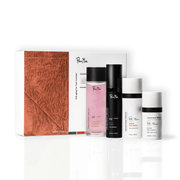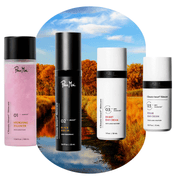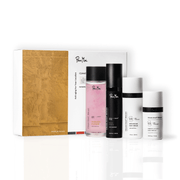28 October 2024
From monsoon moisture to desert dryness, the Southwest can put your skin to the test. Learn how to shield and nourish your complexion, no matter what the weather brings.
Dreaming of Southwestern sunsets and Western vibes? The scenery might be picturesque, but the arid climate can make your skin as dry as a reptile’s. 🦎 If you’re moving from humid to dry climate, skincare adjustments should definitely be on your radar.
The Southwest is a world of climate contrasts, where scorching deserts meet torrential monsoons. This dramatic shift can leave your skin parched and confused, especially in states like California, Arizona, New Mexico, and Texas.
Thanks to meticulous research developing our Climate-Smart® skincare solutions, we know what it takes to keep your skin agile to shifting seasons. Today, we’ll guide you on how to adapt your routine and keep skin glowing, no matter what the Southwest throws your way.
What are Transitional Seasons in the Southwest?
When it comes to the weather, desert states are known mostly for their dry heat. Sun-soaked days without the mugginess? Sign me up. ☀️
But hold on — there’s a catch. The Southwest also has a monsoon season.
In the case of the North American Monsoon, wind patterns bring moisture from the Pacific Ocean into California, Arizona, New Mexico, and some of Texas [1]. That moisture presents as rainfall and thunderstorms in the summer. Specifically, this monsoon season typically occurs between June 15 to September 30, which makes up most of the season [2].
So your skin may be used to the dry, desert heat, but the monsoon season’s sudden humidity might throw it off balance.
The switch from humid, monsoon air to dry desert days (and back) brings changes to your complexion that you’ll want to address with seasonal skincare.
Humid vs. Dry Heat: How do they Affect the Skin?
Your skincare in Arizona and the greater Southwest is going to be starkly different than other regions in the US. Generally, humid weather causes oily skin, and dry weather causes dry, flaky skin. Still, it’s not always so straightforward. First, the wet and sticky months…
How Humidity Affects Your Skin
With regards to humidity, here’s what Pour Moi Skincare’s expert Dr. O shares:
“Your sebaceous glands overproduce sebum, which is like oil. And this excess of oil can cause a lot of skin problems…such as breaking out, or worsening other conditions like acne or dermatitis.”
Sebaceous glands are found in the mid-dermis (the middle layer of your skin). You have them all over your body, but mostly in your scalp and face. Sebaceous glands secrete different kinds of oils, including triglycerides, squalene, fatty acid products, and cholesterol [3].
According to Dr. O, these glands work overtime with the excess moisture from humidity. On a good day, your skin just has a nice glow. ✨On a bad day, it could trigger acne or an itchy bout of dermatitis (dry rash or irritation from inflamed skin). 😬
We know what you’re thinking: dryness sounds more like a symptom of dry weather, right? Not exclusively — it can still happen due to excess moisture in high humidity.
How Dry Weather Affects Your Skin
Dr. O believes that a dry environment is one of healthy skin’s biggest culprits:
“In a dry environment, water is literally sucked out of the lower layers of your skin, and that impacts your skin barrier.”
Meaning? Your skin just became the desert climate you live in.
“The [skin] cells cannot create a tighter and tighter seal… your [outer layer] develops cracks, and through those cracks not only does moisture escape, but allergens and pollutants and toxins can get into your skin.”
The worst part is, once a few skin cells dry out, the rest quickly follow. This chain reaction is known as cell signaling and can leave your skin feeling dry and flaky. If you have a skin condition, it can sometimes get even worse.
If you live in the Southwest, you’re constantly battling the yearly shift of dry and humid climates. A climate-focused skincare regimen can make all the difference.
Moving from Humid to Dry Climate Skincare in 1, 2, 3
As the monsoon season exits stage left, your skin barrier retains less moisture from the drop in humidity.
Here are three simple steps to keep your skin healthy and hydrated as the weather moves from humid to dry:
1. Stay hydrated
As the air dries out, so too does your complexion. Keep your skin ready for the dry season by drinking plenty of water. 💦
Increased water consumption can improve dry skin and make it even more plump and elastic [4]. Bottoms up!
2. Prioritize SPF
Humidity makes us feel hotter because of the added moisture in the air which increases sweating. Once the dry heat comes back, you might not sweat as much, but the sun still transmits UV rays.
This is especially true for those living in the high desert. In fact, every 1,000 feet of elevation results in an additional 15% of exposure to UV rays [5]. Long story short? Always apply a layer of sunscreen, even if you’re indoors.
3. Invest in seasonal skincare for your climate
A Texas, New Mexico, or Arizona skincare routine won’t adequately address your dry or oily skin if it doesn’t address the changing climates in your environment. The best way to do that? With Pour Moi’s innovative Southwest Region Climate-Smart Rotating Systems.
These systems include a:
- Hydrating Balancer to retain moisture in the skin
- Black Serum formulated with potent age-defying European skin actives
- Desert Day Cream to soften rough and flaky texture (AKA the best moisturizer for desert climates)
Do you live in higher altitudes? Then our Southwest High Desert option is the ideal choice.
This system includes the same Hydrating Balancer and Black Serum as the first system, as well as our:
- Mountain Day Cream to shield your complexion from enhanced UV exposure
- Frosty Summit Day Cream for extra hydration during freezing temperatures (because deserts get chilly, too)
From monsoons to dry spells, this dynamic skincare routine has you covered. 🌧️
Find Your Southwest Glow with Pour Moi Skincare!
Bottom line? Moving from humid to dry climate skincare can feel tedious and confusing if you’re juggling multiple products. 🤹
Pour Moi Skincare’s Climate-Smart Rotating® Systems don’t just make it easy — it’s the only proven solution to address complexion concerns based on the two constants in everyone’s life: your climate and environment.
Don’t let the desert steal your glow. Discover our Southwest Desert skincare systems today!
References:
- NOAA’s National Weather Service. (n.d.-b). North American Monsoon highlights. https://www.weather.gov/abq/northamericanmonsoon-intro
- North American Monsoon and Drought Relief | June 30, 2022 | Drought.gov. (n.d.). Drought.gov. https://www.drought.gov/drought-status-updates/north-american-monsoon-and-drought-relief#:~:text=The%20Southwest%20U.S.%20monsoon%20
- Makrantonaki, E., Ganceviciene, R., & Zouboulis, C. (2011). An update on the role of the sebaceous gland in the pathogenesis of acne. Dermato-endocrinology, 3(1), 41–49. https://doi.org/10.4161/derm.3.1.13900
- Załęcki, P., Rogowska, K., Wąs, P., Łuczak, K., Wysocka, M., & Nowicka, D. (2024). Impact of lifestyle on differences in skin hydration of selected body areas in young women. Cosmetics, 11(1), 13. https://doi.org/10.3390/cosmetics11010013
- Andersen, P. A., Buller, D. B., Walkosz, B. J., Scott, M. D., Maloy, J. A., Cutter, G. R., & Dignan, M. D. (2010). Environmental cues to UV radiation and personal sun protection in outdoor winter recreation. Archives of dermatology, 146(11), 1241–1247. https://doi.org/10.1001/archdermatol.2010.327











